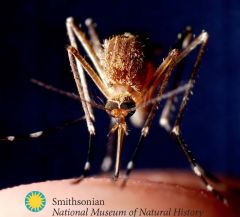Grade Level(s):
- 9-12
- 13-16
Source:
- Smithsonian National Museum of Natural History
Resource type:
- Classroom activity
Time: Seven 50-minute class periods
Overview
In this advanced 4-lesson curriculum unit, students examine evidence to compare four different explanations for why many malarial parasites are resistant to antimalarial drugs; investigate how scientific arguments using G6PD data show support for natural selection in humans; design an investigation using a simulation based on the Hardy-Weinberg principle to explore mechanisms of evolution; and apply their understanding to other alleles that have evolved in response to malaria.

- [Mechanisms of evolution: Grades 9-12] Evolution occurs through multiple mechanisms.
- [Mechanisms of evolution: Grades 9-12] Evolution results from selection acting upon genetic variation within a population. (LS4.B)
- [Mechanisms of evolution: Grades 9-12] Evolution results from genetic drift acting upon genetic variation within a population.
- [Mechanisms of evolution: Grades 9-12] There is variation within a population. (LS3.B)
- [Mechanisms of evolution: Grades 9-12] Natural selection acts on the variation that exists in a population. (LS4.B, LS4.C)
- [Mechanisms of evolution: Grades 9-12] Natural selection acts on phenotype as an expression of genotype.
- [Mechanisms of evolution: Grades 9-12] The amount of genetic variation in a population may affect the chances of survival of the population; the less diversity, the less likely the population will be able to survive environmental change.
- [Mechanisms of evolution: Grades 9-12] Inherited characteristics affect the likelihood of an organism's survival and reproduction. (LS4.B, LS4.C)
- [Mechanisms of evolution: Grades 9-12] Populations, not individuals, evolve.
- [Mechanisms of evolution: Grades 9-12] Traits that confer an advantage may persist in the population and are called adaptations. (LS4.B, LS4.C)
- [Mechanisms of evolution: Grades 9-12] Natural selection is dependent on environmental conditions.
- [Mechanisms of evolution: Grades 9-12] Over time, the proportion of individuals with advantageous characteristics may increase due to their likelihood of surviving and reproducing. (LS4.B, LS4.C)
- [Mechanisms of evolution: Grades 13-16] Evolution is often defined as a change in allele frequencies within a population.
- [Mechanisms of evolution: Grades 13-16] The Hardy-Weinberg equation describes expectations about the gene pool of a population that isn't evolving, that is large, mates randomly, doesn't experience mutation, natural selection, or gene flow.
- [Mechanisms of evolution: Grades 13-16] Evolution occurs through multiple mechanisms.
- [Mechanisms of evolution: Grades 13-16] Evolution results from natural selection acting upon genetic variation within a population.
- [Mechanisms of evolution: Grades 13-16] Evolution results from genetic drift acting upon genetic variation within a population.
- [Mechanisms of evolution: Grades 13-16] Natural selection and genetic drift act on the variation that exists in a population.
- [Mechanisms of evolution: Grades 13-16] Natural selection acts on phenotype as an expression of genotype.
- [Mechanisms of evolution: Grades 13-16] Inherited characteristics affect the likelihood of an organism's survival and reproduction.
- [Mechanisms of evolution: Grades 13-16] Over time, the proportion of individuals with advantageous traits may increase (and the proportion with disadvantageous traits may decrease) due to their chances of surviving and reproducing.
- [Mechanisms of evolution: Grades 13-16] Traits that confer an advantage may persist in the population and are called adaptations.
- [Mechanisms of evolution: Grades 13-16] Depending on environmental conditions, inherited characteristics may be advantageous, neutral, or detrimental.
- [Nature of science: Grades 9-12] A hallmark of science is exposing ideas to testing. (P3, P4, P6, P7)
- [Nature of science: Grades 9-12] Scientists test their ideas using multiple lines of evidence. (P6, NOS2)
- [Nature of science: Grades 9-12] Scientists use multiple research methods (experiments, observational research, comparative research, and modeling) to collect data. (P2, P3, P4, NOS1)
- [Nature of science: Grades 13-16] A hallmark of science is exposing ideas to testing.
- [Nature of science: Grades 13-16] Scientists test their ideas using multiple lines of evidence.
- [Nature of science: Grades 13-16] Scientists use multiple research methods (experiments, observational research, comparative research, and modeling) to collect data.
- [Studying evolution: Grades 9-12] As with other scientific disciplines, evolutionary biology has applications that factor into everyday life.
- [Studying evolution: Grades 13-16] As with other scientific disciplines, evolutionary biology has applications that factor into everyday life, for example in agriculture, biodiversity and conservation biology, and medicine and health.
- Disciplinary Core Idea LS3.B: Variation of Traits
- Disciplinary Core Idea LS4.B: Natural Selection
- Disciplinary Core Idea LS4.C: Adaptation
- NOS Matrix understanding category 1. Scientific investigations use a variety of methods.
- NOS Matrix understanding category 2. Scientific knowledge is based on empirical evidence.
- Science and Engineering Practice 2. Developing and using models
- Science and Engineering Practice 4. Analyzing and interpreting data
- Science and Engineering Practice 6. Constructing explanations and designing solutions
- Science and Engineering Practice 7. Engaging in argument from evidence
These lessons were designed for AP biology, but would work for college students as well. A condensed lesson sequence is available.
